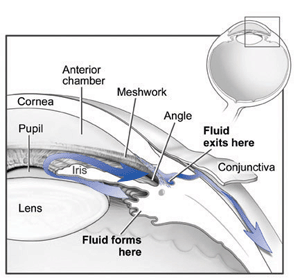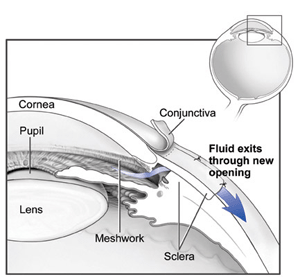Glaucoma needs to be detected as early as possible to prevent damage to vision. The treatment aims to reduce the pressure within the affected eye. Treatment includes medications in the form of eye drops and oral pills and surgical methods.
Treatment of Chronic open angle glaucoma
Medications
Both open and closed angle glaucoma may be treated with eye drops. There are several different types of eye drops available. Eye drops are generally applied after gently pulling down the lower eyelid, holding the bottle over the eye and allowing the required number of drops to fall into the pocket of the lower lid. The eyes are then kept closed for several minutes.

Those wearing contact lenses may need to discontinue them and use glasses while using eye medication. This is because the medication in the eye drops can build up in the lenses and may harm the eyes.
The different types of eye drops and pills include:-
Prostaglandin analogues
The commonly used medications are Latanoprost, Bimatoprost, Travoprost, tafluprost etc. that are prostaglandin analogues. It increases the flow of aqueous humour from the eye via the drainage networks and reduces the pressure. These eye drops are usually used once a day. Common side effects include reddening of the eyes, hair loss lamisil darker eye color, thickening and darkening of eyelashes, pain and irritation in the eyes, red and swollen rims of the eyes, dry eyes, sensitivity to light and headaches.
Beta-blockers
These reduce the intraocular pressure by slowing down the production of aqueous humour in the eyes. They are used once or twice a day. Common side effects include burning or stinging, dry eyes, itchiness in eyes etc. Commonly used drugs include betaxolol, timolol etc.
Sympathomimetics
These reduce the rate of production of aqueous humour and increase the flow of aqueous humour out of the eyes. These eye drops are used twice a day. Common side effects include red and painful sensations of the eyes and dry eyes. Drugs include brimonidine tartarate, apraclonidine etc.
Carbonic anhydrase inhibitors
These can be prescribed as pills as well as drops. Carbonic anhydrase inhibitors reduce the amount of aqueous humour produced in the eyes. These drops are used two or three times a day. They can also be taken as twice daily pills. Oral pills contain Acetazolamide and eye drops contain dorzolamide and brinzolamide. Side effects include nausea, dry mouth, eye irritation, bitter taste etc.
Laser therapy
This treatment uses high energy beams of light that are used to open up the blocked trabecular meshwork in the angles of the eyes. A 50 μm argon laser spot is aimed at the trabecular meshwork. This is called laser trabeculoplasty. Before the procedure a local anesthetic agent is applied on the eye to prevent pain. Laser is shone through the lens and this makes small holes in the trabecular meshwork. This finally allows more fluid to drain out of the anterior chamber and reduces the intraocular pressure.
Another alternative therapy is cyclodiode laser treatment. This involves destroying some of the tissue in the eye that produces aqueous humour. This less aqueous humor is produced and this reduces the intraocular pressure. These therapies are usually quick and painless (apart from a slight pricking irritation)
Surgical therapy
Surgery is usually trabeculectomy to remove part of the trabecular meshwork to allow fluid to flow through the eye's drainage system. The procedure may be done under local or general anesthesia.
Other surgical procedures include viscocanalostomy (removal of part of the sclera to allow the fluid to filter out of the eye into the body), deep sclerectomy (implanting a tiny device inside the eye to widen the trabecular meshwork) or an aqueous shunt implant (implanting a tube device into the eye to improve drainage.
Another surgery is the canaloplasty. This is a nonpenetrating procedure utilizing microcatheter technology. A tiny cut is made into the eye to gain access to Schlemm's canal like in viscocanalostomy. A tiny thin hollow tube or microcatheter is inserted to circumnavigate the canal around the iris, enlarging the main drainage channel and its smaller collector channels. The enlargement is done by injection of a sterile, gel-like material called viscoelastic. The microcatheter is then removed and a suture is placed within the canal and tightened.

Treatment of acute angle closure glaucoma
This condition develops rapidly and needs emergency and urgent treatment to prevent loss of vision. Treatment involves use of eye drops (similar to those used in open angle glaucoma), oral pills and injections to reduce the pressure inside the eyes and laser and surgical therapy.
Medications are similar as those used in open angle glaucoma. Other agents include miotics. Acute angle-closure glaucoma may also be treated with miotics such as pilocarpine. Miotics work by opening up the blocked trabecular meshwork by contracting the pupils. These may be prescribed for up to four times a day. These may cause side effects such as burning, itching eyes, blurred vision, headache etc.
Laser therapy usually involves laser iridotomy that uses laser to create holes in the iris to open the angle and enable fluid to flow. Both the eyes may need to be treated, even if only one has acute angle-closure glaucoma. This is because both eyes are susceptible. YAG laser peripheral iridotomy (LPI) may be used in patients susceptible to or affected by angle closure glaucoma or pigment dispersion syndrome. As surgical therapy a trabeculectomy is performed to remove part of the drainage tubes.
Sources
- http://www.nhs.uk/Conditions/Glaucoma/Pages/Treatment.aspx
- http://www.patient.co.uk/doctor/glaucoma-and-ocular-hypertension
- http://www.bbc.co.uk/health/physical_health/conditions/glaucoma1.shtml
- http://www.glaucomafoundation.org/docs/PatientGuide.pdf
- http://www.eyes.arizona.edu/Teaching/MedStudents/Glaucoma.pdf
Further Reading
- All Glaucoma Content
- What is Glaucoma?
- What is Open-Angle Glaucoma?
- Glaucoma Pathophysiology
- Glaucoma Causes
Last Updated: Feb 26, 2019

Written by
Dr. Ananya Mandal
Dr. Ananya Mandal is a doctor by profession, lecturer by vocation and a medical writer by passion. She specialized in Clinical Pharmacology after her bachelor's (MBBS). For her, health communication is not just writing complicated reviews for professionals but making medical knowledge understandable and available to the general public as well.
Source: Read Full Article